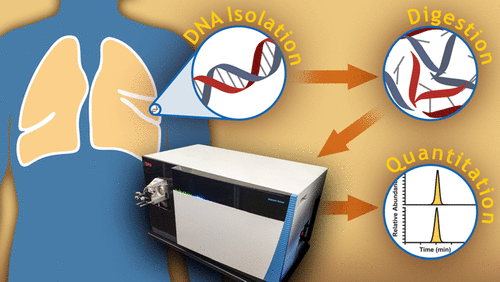当前位置:
X-MOL 学术
›
Anal. Chem.
›
论文详情
Our official English website, www.x-mol.net, welcomes your
feedback! (Note: you will need to create a separate account there.)
Ultrasensitive High-Resolution Mass Spectrometric Analysis of a DNA Adduct of the Carcinogen Benzo[a]pyrene in Human Lung
Analytical Chemistry ( IF 6.7 ) Pub Date : 2017-11-17 00:00:00 , DOI: 10.1021/acs.analchem.7b02856 Peter W. Villalta 1 , J. Bradley Hochalter 1 , Stephen S. Hecht 1
Analytical Chemistry ( IF 6.7 ) Pub Date : 2017-11-17 00:00:00 , DOI: 10.1021/acs.analchem.7b02856 Peter W. Villalta 1 , J. Bradley Hochalter 1 , Stephen S. Hecht 1
Affiliation

|
Benzo[a]pyrene (BaP), an archetypical polycyclic aromatic hydrocarbon, is classified as “carcinogenic to humans” and is ubiquitous in the environment, as evident by the measurable levels of BaP metabolites in virtually all human urine samples examined. BaP carcinogenicity is believed to occur mainly through its covalent modification of DNA, resulting in the formation of BPDE–N2-dG, an adduct formed between deoxyguanosine and a diol epoxide metabolite of BaP, with subsequent mutation of critical growth control genes. In spite of the liquid chromatography–mass spectrometry (LC–MS)-based detection of BPDE–N2-dG in BaP-treated rodents, and indirectly through high-performance liquid chromatography (HPLC)-fluorescence detection of BaP-7,8,9,10-tetraols released from human DNA upon acid hydrolysis, BPDE–N2-dG adducts have rarely if ever been observed directly in human samples using LC–MS techniques, even though sophisticated methodologies have been employed which should have had sufficient sensitivity. With this in mind, we developed a liquid chromatography–electrospray ionization tandem mass spectrometry (LC–ESI-MS/MS) methodology employing high-resolution/accurate mass analysis for detecting ultratrace levels of these adducts. These efforts are directly translatable to the development of sensitive detection of other small molecules using trap-based LC–ESI-MS/MS detection. The developed methodology had a limit of detection (LOD) of 1 amol of BPDE–N2-dG on-column, corresponding to 1 BPDE–N2-dG adduct per 1011 nucleotides (1 adduct per 10 human lung cells) using 40 μg of human lung DNA. To our knowledge, this is the most sensitive DNA adduct quantitation method yet reported, exceeding the sensitivity of the 32P-postlabeling assay (∼1 adduct per 1010 nucleotides). Twenty-nine human lung DNA samples resulted in 20 positive measurements above the LOD, with smoker and nonsmoker DNA containing 3.1 and 1.3 BPDE–N2-dG adducts per 1011 nucleotides, respectively.
中文翻译:

人肺致癌物苯并[ a ] re的DNA加合物的超灵敏高分辨率质谱分析
苯并[一个]芘(BAP),一个原型多环芳烃,被分类为“人类致癌物”,并且是普遍存在的环境中,如由BaP的代谢物的可测量水平的明显,在几乎所有的人类尿样品检查。据认为,BaP的致癌性主要是通过对DNA的共价修饰而导致的,从而导致BPDE– N 2 -dG的形成,BPDE– N 2 -dG是脱氧鸟苷与BaP的二醇环氧代谢产物之间形成的加合物,随后突变了关键的生长控制基因。尽管基于液相色谱-质谱(LC-MS)的BPDE- N 2检测-dG在BaP处理的啮齿动物中,以及通过高效液相色谱(HPLC)间接检测-荧光检测酸水解后从人类DNA释放的BaP-7,8,9,10-四醇,BPDE– N 2即使使用LC-MS技术在人类样品中直接观察到-dG加合物,即使已经采用了应该具有足够灵敏度的精密方法,也很少有人观察到。考虑到这一点,我们开发了一种液相色谱-电喷雾串联质谱法(LC-ESI-MS / MS),该方法采用高分辨率/准确的质量分析方法来检测这些加合物的超痕量水平。这些努力可直接转化为使用基于阱的LC–ESI-MS / MS检测技术开发其他小分子的灵敏检测方法。该改进的方法具有检测限(LOD)1个AMOL BPDE-的的限制Ñ 2柱上-dG,对应于1 BPDE- Ñ 2 -dG加合物每10 11核苷酸(每10个人肺细胞中有1个加合物),使用的是40μg人肺DNA。据我们所知,这是迄今报道的最敏感的DNA加合物定量方法,超过了32 P后标记测定的灵敏度(每10 10个核苷酸约1个加合物)。29个人肺DNA样品在LOD之上产生了20个阳性结果,吸烟者和非吸烟者的DNA分别每10 11个核苷酸含有3.1和1.3 BPDE– N 2 -dG加合物。
更新日期:2017-11-19
中文翻译:

人肺致癌物苯并[ a ] re的DNA加合物的超灵敏高分辨率质谱分析
苯并[一个]芘(BAP),一个原型多环芳烃,被分类为“人类致癌物”,并且是普遍存在的环境中,如由BaP的代谢物的可测量水平的明显,在几乎所有的人类尿样品检查。据认为,BaP的致癌性主要是通过对DNA的共价修饰而导致的,从而导致BPDE– N 2 -dG的形成,BPDE– N 2 -dG是脱氧鸟苷与BaP的二醇环氧代谢产物之间形成的加合物,随后突变了关键的生长控制基因。尽管基于液相色谱-质谱(LC-MS)的BPDE- N 2检测-dG在BaP处理的啮齿动物中,以及通过高效液相色谱(HPLC)间接检测-荧光检测酸水解后从人类DNA释放的BaP-7,8,9,10-四醇,BPDE– N 2即使使用LC-MS技术在人类样品中直接观察到-dG加合物,即使已经采用了应该具有足够灵敏度的精密方法,也很少有人观察到。考虑到这一点,我们开发了一种液相色谱-电喷雾串联质谱法(LC-ESI-MS / MS),该方法采用高分辨率/准确的质量分析方法来检测这些加合物的超痕量水平。这些努力可直接转化为使用基于阱的LC–ESI-MS / MS检测技术开发其他小分子的灵敏检测方法。该改进的方法具有检测限(LOD)1个AMOL BPDE-的的限制Ñ 2柱上-dG,对应于1 BPDE- Ñ 2 -dG加合物每10 11核苷酸(每10个人肺细胞中有1个加合物),使用的是40μg人肺DNA。据我们所知,这是迄今报道的最敏感的DNA加合物定量方法,超过了32 P后标记测定的灵敏度(每10 10个核苷酸约1个加合物)。29个人肺DNA样品在LOD之上产生了20个阳性结果,吸烟者和非吸烟者的DNA分别每10 11个核苷酸含有3.1和1.3 BPDE– N 2 -dG加合物。











































 京公网安备 11010802027423号
京公网安备 11010802027423号